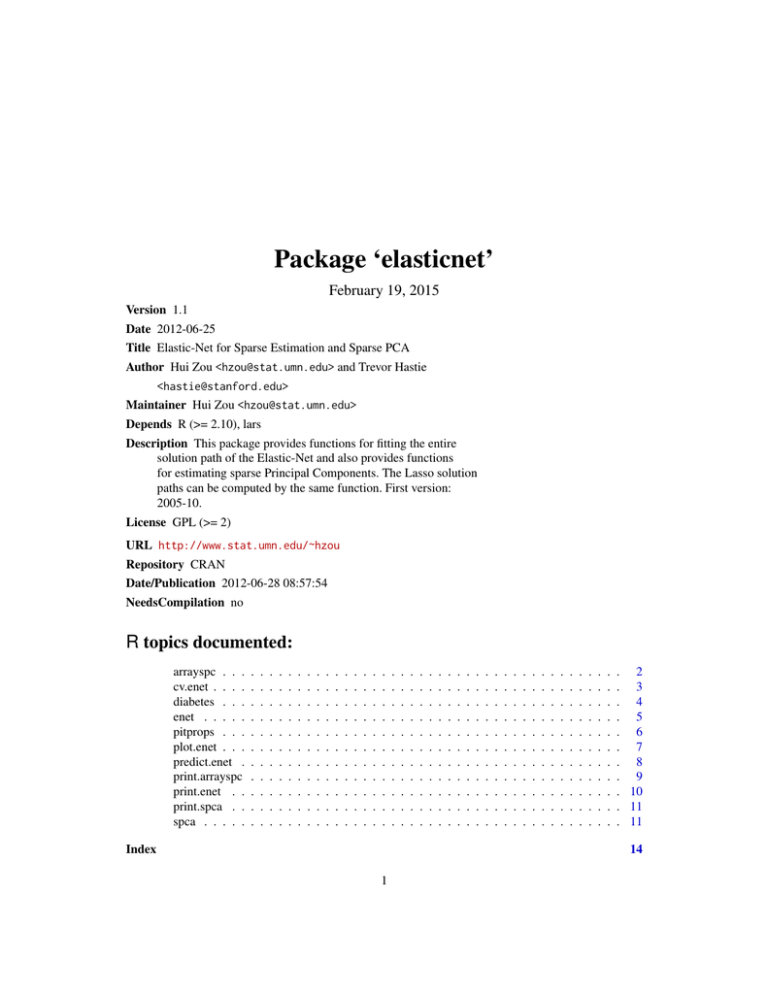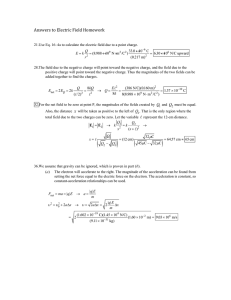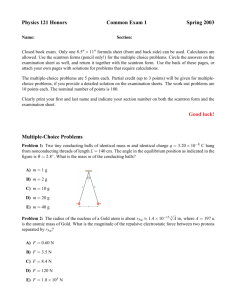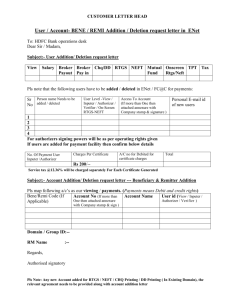Package `elasticnet`
advertisement

Package ‘elasticnet’ February 19, 2015 Version 1.1 Date 2012-06-25 Title Elastic-Net for Sparse Estimation and Sparse PCA Author Hui Zou <hzou@stat.umn.edu> and Trevor Hastie <hastie@stanford.edu> Maintainer Hui Zou <hzou@stat.umn.edu> Depends R (>= 2.10), lars Description This package provides functions for fitting the entire solution path of the Elastic-Net and also provides functions for estimating sparse Principal Components. The Lasso solution paths can be computed by the same function. First version: 2005-10. License GPL (>= 2) URL http://www.stat.umn.edu/~hzou Repository CRAN Date/Publication 2012-06-28 08:57:54 NeedsCompilation no R topics documented: arrayspc . . . cv.enet . . . . diabetes . . . enet . . . . . pitprops . . . plot.enet . . . predict.enet . print.arrayspc print.enet . . print.spca . . spca . . . . . . . . . . . . . . . . . . . . . . . . . . . . . . . . . . . . . . . . . . . . . . . . . . . . . . . . . . . . . . . . . . . . . . . . . . . . . . . . . . . . . . . . . . . . . . . . . . . . . . . . . . . . . . . . . . . . . . . . . . . . . . . . . . . . . . . . . . . . . . . . . . . . . . . . . . . . . . . . . . . . . . . . . . Index . . . . . . . . . . . . . . . . . . . . . . . . . . . . . . . . . . . . . . . . . . . . . . . . . . . . . . . . . . . . . . . . . . . . . . . . . . . . . . . . . . . . . . . . . . . . . . . . . . . . . . . . . . . . . . . . . . . . . . . . . . . . . . . . . . . . . . . . . . . . . . . . . . . . . . . . . . . . . . . . . . . . . . . . . . . . . . . . . . . . . . . . . . . . . . . . . . . . . . . . . . . . . . . . . . . . . . . . . . . . . . . . . . . . . . . . . . . . . . . . . . . . . . . . . . . . . . . . . . . . . . . . . 2 . 3 . 4 . 5 . 6 . 7 . 8 . 9 . 10 . 11 . 11 14 1 2 arrayspc arrayspc Sparse PCs of Microarrays Description Sparse PC by iterative SVD and soft-thresholding Usage arrayspc(x,K=1,para,use.corr=FALSE, max.iter=100,trace=FALSE,eps=1e-3) Arguments x The microarray matrix. K Number of components. Default is 1. para The thresholding parameters. A vector of length K. use.corr Perform PCA on the correlation matrix? This option is only effective when the argument type is set "data". max.iter Maximum number of iterations. trace If TRUE, prints out its progress. eps Convergence criterion. Details The function is equivalent to a special case of spca() with the quadratic penalty=infinity. It is specifically designed for the case p»n, like microarrays. Value A "arrayspc" object is returned. Author(s) Hui Zou, Trevor Hastie and Robert Tibshirani References Zou, H., Hastie, T. and Tibshirani, R. (2004) "Sparse principal component analysis" Technical report, Statistics Dept. Stanford University See Also spca, princomp cv.enet cv.enet 3 Computes K-fold cross-validated error curve for elastic net Description Computes the K-fold cross-validated mean squared prediction error for elastic net. Usage cv.enet(x, y, K = 10, lambda, s, mode,trace = FALSE, plot.it = TRUE, se = TRUE, ...) Arguments x Input to lars y Input to lars K Number of folds lambda Quadratic penalty parameter s Abscissa values at which CV curve should be computed. A value, or vector of values, indexing the path. Its values depends on the mode= argument mode Mode="step" means the s= argument indexes the LARS-EN step number. If mode="fraction", then s should be a number between 0 and 1, and it refers to the ratio of the L1 norm of the coefficient vector, relative to the norm at the full LS solution. Mode="norm" means s refers to the L1 norm of the coefficient vector. Abbreviations allowed. If mode="norm", then s should be the L1 norm of the coefficient vector. If mode="penalty", then s should be the 1-norm penalty parameter. trace Show computations? plot.it Plot it? se Include standard error bands? ... Additional arguments to enet Value Invisibly returns a list with components (which can be plotted using plotCVLars) fraction Values of s cv The CV curve at each value of fraction cv.error The standard error of the CV curve Author(s) Hui Zou and Trevor Hastie 4 diabetes References Zou and Hastie (2005) "Regularization and Variable Selection via the Elastic Net" Journal of the Royal Statistical Society, Series B,76,301-320. Examples data(diabetes) attach(diabetes) ## use the L1 fraction norm as the tuning parameter cv.enet(x2,y,lambda=0.05,s=seq(0,1,length=100),mode="fraction",trace=TRUE,max.steps=80) ## use the number of steps as the tuning parameter cv.enet(x2,y,lambda=0.05,s=1:50,mode="step") detach(diabetes) diabetes Blood and other measurements in diabetics Description The diabetes data frame has 442 rows and 3 columns. These are the data used in the Efron et al "Least Angle Regression" paper. Format This data frame contains the following columns: x a matrix with 10 columns y a numeric vector x2 a matrix with 64 columns Details The x matrix has been standardized to have unit L2 norm in each column and zero mean. The matrix x2 consists of x plus certain interactions. Source http://www-stat.stanford.edu/~hastie/Papers/LARS/LeastAngle_2002.ps References Efron, Hastie, Johnstone and Tibshirani (2003) "Least Angle Regression" (with discussion) Annals of Statistics enet 5 enet Fits Elastic Net regression models Description Starting from zero, the LARS-EN algorithm provides the entire sequence of coefficients and fits. Usage enet(x, y, lambda, max.steps, normalize=TRUE, intercept=TRUE, trace = FALSE, eps = .Machine$double.eps Arguments x matrix of predictors y response lambda Quadratic penalty parameter. lambda=0 performs the Lasso fit. max.steps Limit the number of steps taken; the default is 50 * min(m, n-1), with m the number of variables, and n the number of samples. One can use this option to perform early stopping. trace If TRUE, prints out its progress normalize Standardize the predictors? intercept Center the predictors? eps An effective zero Details The Elastic Net methodology is described in detail in Zou and Hastie (2004). The LARS-EN algorithm computes the complete elastic net solution simultaneously for ALL values of the shrinkage parameter in the same computational cost as a least squares fit. The structure of enet() is based on lars() coded by Efron and Hastie. Some internel functions from the lars package are called. The user should install lars before using elasticnet functions. Value An "enet" object is returned, for which print, plot and predict methods exist. Author(s) Hui Zou and Trevor Hastie References Zou and Hastie (2005) "Regularization and Variable Selection via the Elastic Net" Journal of the Royal Statistical Society, Series B, 67, 301-320. 6 pitprops See Also print, plot, and predict methods for enet Examples data(diabetes) attach(diabetes) ##fit the lasso model (treated as a special case of the elastic net) object1 <- enet(x,y,lambda=0) plot(object1) ##fit the elastic net model with lambda=1. object2 <- enet(x,y,lambda=1) plot(object2) ##early stopping after 50 LARS-EN steps object4 <- enet(x2,y,lambda=0.5,max.steps=50) plot(object4) detach(diabetes) pitprops Pitprops correlation data Description The pitprops data is a correlation matrix that was calculated from 180 observations. There are 13 explanatory variables. Usage data(pitprops) Details Jeffers (1967) tried to interpret the first six PCs. This is a classical example showing the difficulty of interpreting principal components. References Jeffers, J. (1967) "Two case studies in the application of principal component", Applied Statistics, 16, 225-236. plot.enet plot.enet 7 Plot method for enet objects Description Produce a plot of an enet fit. The default is a complete coefficient path. Usage ## S3 method for class 'enet' plot(x, xvar = c("fraction", "penalty", "L1norm", "step"), use.color = FALSE, ...) Arguments x enet object xvar The type of x variable against which to plot. xvar=fraction plots agains the fraction of the L1 norm of the coefficient vector (default). xvar=penalty plots against the 1-norm penalty parameter. xvar=L1norm plots against the L1 norm of the coefficient vector. xvar=step plots against the LARS-EN step number. use.color a colorful plot? ... Additonal arguments for generic plot. Value NULL Author(s) Hui Zou and Trevor Hastie References Zou and Hastie (2005) "Regularization and Variable Selection via the Elastic Net" Journal of the Royal Statistical Society, Series B,67,301-320. Examples data(diabetes) attach(diabetes) object <- enet(x,y,lambda=1) par(mfrow=c(2,2)) plot(object) plot(object,xvar="step") detach(diabetes) 8 predict.enet predict.enet Make predictions or extract coefficients from a fitted elastic net model Description While enet() produces the entire path of solutions, predict.enet allows one to extract a prediction at a particular point along the path. Usage ## S3 method for class 'enet' predict(object, newx, s, type = c("fit", "coefficients"), mode = c("step","fraction", "norm", "penalty"),naive=FALSE, ...) Arguments object A fitted enet object newx If type="fit", then newx should be the x values at which the fit is required. If type="coefficients", then newx can be omitted. s a value, or vector of values, indexing the path. Its values depends on the mode= argument. By default (mode="step"). type If type="fit", predict returns the fitted values. If type="coefficients", predict returns the coefficients. Abbreviations allowed. mode Mode="step" means the s= argument indexes the LARS-EN step number, and the coefficients will be returned corresponding to the values corresponding to step s. If mode="fraction", then s should be a number between 0 and 1, and it refers to the ratio of the L1 norm of the coefficient vector, relative to the norm at the full LS solution. Mode="norm" means s refers to the L1 norm of the coefficient vector. Abbreviations allowed. If mode="norm", then s should be the L1 norm of the coefficient vector. If mode="penalty", then s should be the 1-norm penalty parameter. naive IF naive is True, then the naive elastic net fit is returned. ... Additonal arguments for generic print. Details Starting from zero, the LARS-EN algorithm provides the entire sequence of coefficients and fits. Value Either a vector/matrix of fitted values, or a vector/matrix of coefficients. Author(s) Hui Zou and Trevor Hastie print.arrayspc 9 References Zou and Hastie (2005) "Regularization and Variable Selection via the Elastic Net" Journal of the Royal Statistical Society, Series B,67,301-320. See Also print, plot, enet Examples data(diabetes) attach(diabetes) object <- enet(x,y,lambda=0.1) ### make predictions at the values in x, at each of the ### steps produced in object fits <- predict.enet(object, x, type="fit") ### extract the coefficient vector with L1 norm=2000 coef2000 <- predict(object, s=2000, type="coef", mode="norm") ### extract the coefficient vector with L1 norm fraction=0.45 coef.45 <- predict(object, s=0.45, type="coef", mode="fraction") detach(diabetes) print.arrayspc Print method for arrayspc objects Description Print out an arrayspc fit. Usage ## S3 method for class 'arrayspc' print(x, ...) Arguments x arrayspc object ... Additonal arguments for generic print. Value NULL Author(s) Hui Zou and Trevor Hastie 10 print.enet References Zou, H., Hastie, T. and Tibshirani, R. (2004) "Sparse principal component analysis" Technical report, Statistics Dept. Stanford University. print.enet Print method for enet objects Description Print out an enet fit. Usage ## S3 method for class 'enet' print(x, ...) Arguments x enet object ... Additonal arguments for generic print. Value NULL Author(s) Hui Zou and Trevor Hastie References Zou and Hastie (2005) "Regularization and Variable Selection via the Elastic Net" Journal of the Royal Statistical Society, Series B,67,301-320. print.spca print.spca 11 Print method for spca objects Description Print out a spca fit. Usage ## S3 method for class 'spca' print(x, ...) Arguments x spca object ... Additonal arguments for generic print. Value NULL Author(s) Hui Zou and Trevor Hastie References Zou, H., Hastie, T. and Tibshirani, R. (2004) "Sparse principal component analysis" Technical report, Statistics Dept. Stanford University. spca Sparse Principal Components Analysis Description Using an alternating minimization algorithm to minimize the SPCA criterion. Usage spca(x,K,para,type=c("predictor","Gram"),sparse=c("penalty","varnum"),use.corr=FALSE,lambda=1e-6,max 12 spca Arguments x A matrix. It can be the predictor matrix or the sample covariance/correlation matrix. K Number of components para A vector of length K. All elements should be positive. If sparse="varnum", the elements integers. type If type="predictor", x is the predictor matrix. If type="Gram", the function asks the user to provide the sample covariance or correlation matrix. sparse If sparse="penalty", para is a vector of 1-norm penalty parameters. If sparse="varnum", para defines the number of sparse loadings to be obtained. This option is not discussed in the paper given below, but it is convenient in practice. lambda Quadratic penalty parameter. Default value is 1e-6. use.corr Perform PCA on the correlation matrix? This option is only effective when the argument type is set "data". max.iter Maximum number of iterations. trace If TRUE, prints out its progress. eps.conv Convergence criterion. Details PCA is shown to be equivalent to a regression-type optimization problem, then sparse loadings are obtained by imposing the 1-norm constraint on the regression coefficients. If x is a microarray matrix, use arrayspc(). Value A "spca" object is returned. The below are some quantities which the user may be interested in: loadings The loadings of the sparse PCs pev Percentage of explained variance var.all Total variance of the predictors Author(s) Hui Zou, Trevor Hastie and Robert Tibshirani References Zou, H., Hastie, T. and Tibshirani, R. (2004) "Sparse principal component analysis" Technical report, Statistics Dept. Stanford University. See Also princomp, arrayspc spca 13 Examples data(pitprops) out1<-spca(pitprops,K=6,type="Gram",sparse="penalty",trace=TRUE,para=c(0.06,0.16,0.1,0.5,0.5,0.5)) ## print the object out1 out1 out2<-spca(pitprops,K=6,type="Gram",sparse="varnum",trace=TRUE,para=c(7,4,4,1,1,1)) out2 ## to see the contents of out2 names(out2) ## to get the loadings out2$loadings Index ∗Topic datasets diabetes, 4 pitprops, 6 ∗Topic hplot plot.enet, 7 ∗Topic methods plot.enet, 7 predict.enet, 8 print.arrayspc, 9 print.enet, 10 print.spca, 11 ∗Topic multivariate arrayspc, 2 spca, 11 ∗Topic regression cv.enet, 3 enet, 5 predict.enet, 8 arrayspc, 2 cv.enet, 3 diabetes, 4 enet, 5 pitprops, 6 plot.enet, 7 predict.enet, 8 print.arrayspc, 9 print.enet, 10 print.spca, 11 spca, 11 14



